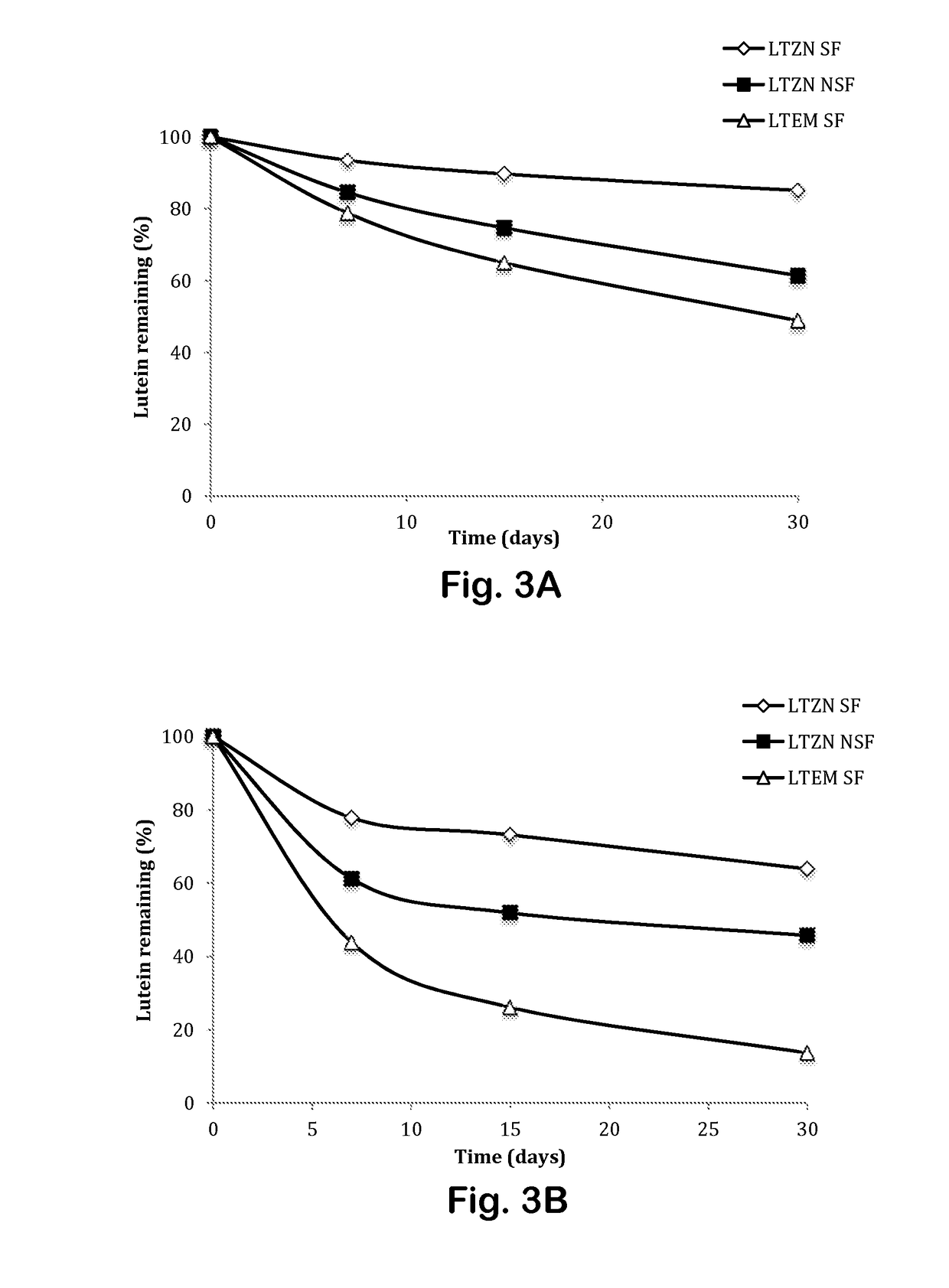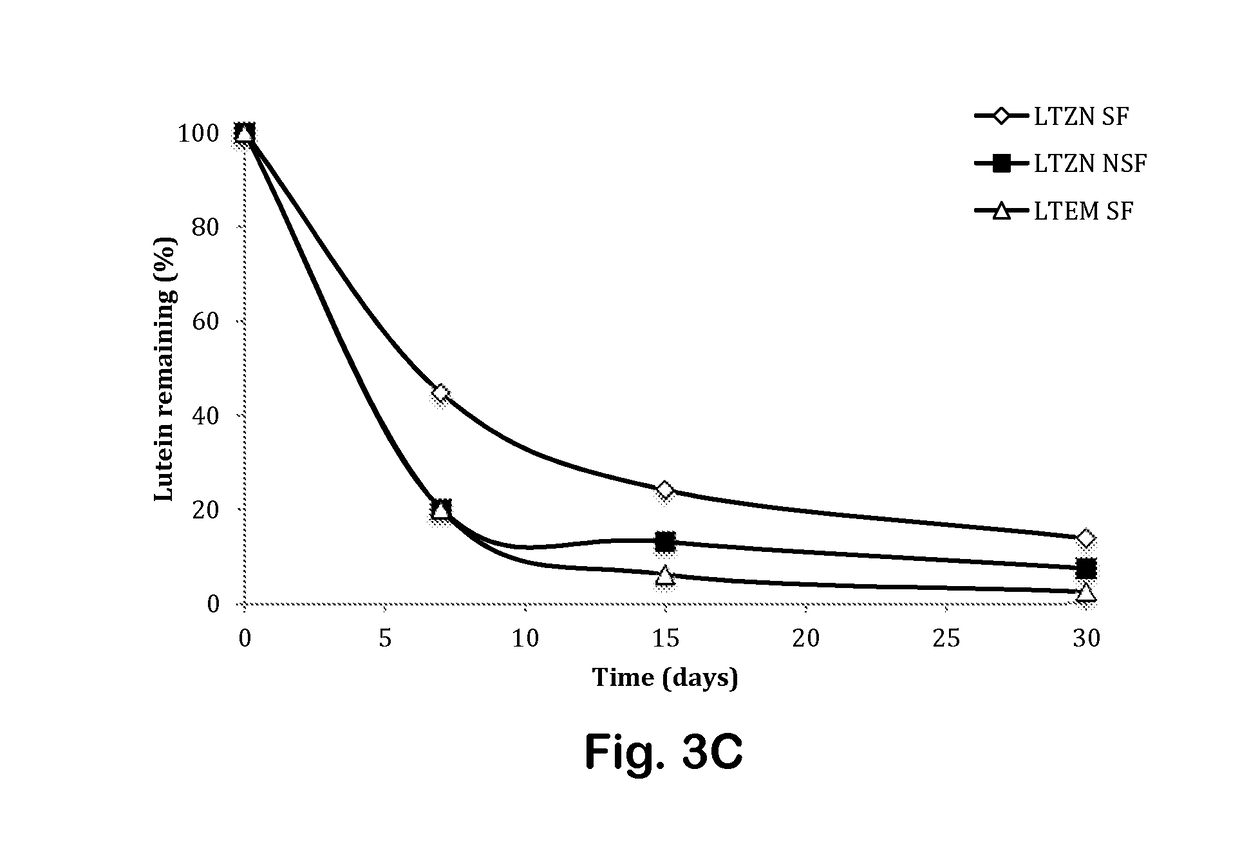Delivery of Bioactive, Nanoencapsulated Antioxidants
a nano-encapsulated, bioactive technology, applied in the direction of capsule delivery, microcapsules, drug compositions, etc., can solve the problems of difficult to deliver lutein to tissues where needed, lutein is susceptible to degradation by light, oxygen and heat, and is difficult to deliver lutein to tissues, etc., to promote slow release of lutein or other antioxidants, improve the chemical stability of entrapped bioactive lutein, and promote the effect of lutein or other
- Summary
- Abstract
- Description
- Claims
- Application Information
AI Technical Summary
Benefits of technology
Problems solved by technology
Method used
Image
Examples
example 1
[0030]Zein, Pluronic F127, chloroform, ethanol, pepsin and pancreatin were purchased from Sigma-Aldrich (Sigma Chemical Co. Ltd., St. Louis, Mo.). Soybean lecithin, hydrochloric acid, and sodium hydroxide were purchased from Fisher Chemical (Fisher Scientific International, Fairlawn, N.J.). Lutein was provided by Kemin Foods, L.C. (Iowa, USA). Nanopure water was obtained using Nanopure Diamond 100 kDA Cellulose Ester Biotech membrane tubing (Barnstead international, IA, USA), and closures were purchased from Spectrum Laboratories Inc. (CA, USA). All other reagents and components used were analytical grade.
Methods
example 2
of Zein Nanoparticles with Entrapped Lutein
[0031]Nanoparticles were synthesized by liquid-liquid dispersion. 10 mg zein was dissolved in 1 ml ethanol-aqueous solution (70:30, v / v). A 0.75 mg / ml lutein solution was prepared in 100% ethanol, which was added dropwise to the zein solution at a 1:1 ratio (v / v) under mild stirring conditions. The mixture was then injected into 7.5 ml of an aqueous phase containing a combination of lecithin and Pluronic F127 0.045%:0.09% (w / v) as surfactants. The sample was then processed in a microfluidizer at 30,000 PSI for 3 cycles (M-110P, Microfluidics, MA, USA). Subsequently, ethanol was evaporated under partial vacuum (at approximately 500-600 mmHg) and nitrogen injection (80 mm Hg) in a rotovapor (Buchi R-124, Buchi Analytical Inc., DE, USA). The lutein-loaded zein nanoparticles remaining after the complete evaporation of ethanol were washed by dialysis using a 100 kDa Spectra / POR CE membrane (Spectrum Rancho, Calif., USA). The nanoparticle suspens...
example 3
Size, Polydispersity Index (PDI), and Zeta Potential
[0032]Freshly-prepared nanoparticle samples were characterized by measuring average particle size, PDI, and zeta potential by dynamic light scattering (DLS), using a Malvern Zetasizer Nano ZS (Malvern Instruments Ltd., Worcestershire, U.K.). Before the measurements were made, samples were diluted to a final concentration range of 0.2-0.32 mg / ml. Citrate buffer at pH 7.4 (0.1 M) was added to stabilize the samples and to inhibit particle aggregation. All measurements were performed in triplicate.
PUM
| Property | Measurement | Unit |
|---|---|---|
| diameter | aaaaa | aaaaa |
| diameter | aaaaa | aaaaa |
| temperatures | aaaaa | aaaaa |
Abstract
Description
Claims
Application Information
 Login to View More
Login to View More - R&D
- Intellectual Property
- Life Sciences
- Materials
- Tech Scout
- Unparalleled Data Quality
- Higher Quality Content
- 60% Fewer Hallucinations
Browse by: Latest US Patents, China's latest patents, Technical Efficacy Thesaurus, Application Domain, Technology Topic, Popular Technical Reports.
© 2025 PatSnap. All rights reserved.Legal|Privacy policy|Modern Slavery Act Transparency Statement|Sitemap|About US| Contact US: help@patsnap.com



